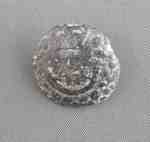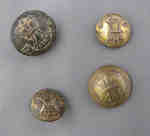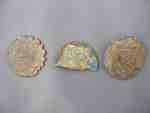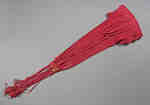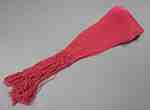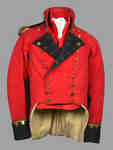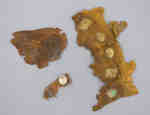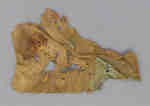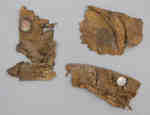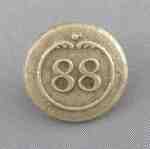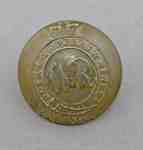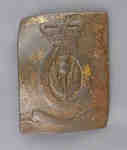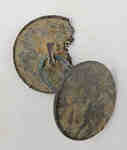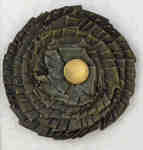Results
- A light infantry button that measures 1.5cm in diameter and has laurel leaves around the outside edge. It was found in the Niagara-on-the-lake/Queenston area.A light infantry button that measures 1.5cm in diameter and has laurel …
- A British infantry regiment that was raised in 1751 and amalgamated with the 52nd (Oxfordshire) Regiment of Foot, to form the Oxfordshire and Buckinghamshire Light Infantry in 1881. It is believed thA British infantry regiment that was raised in 1751 and amalgamated with …
- Buttons have three raised cannon balls in a horizontal row across the top and three raised cannons in a vertical row that are set in a shield. It is believed that this button is from the War of 1812.Buttons have three raised cannon balls in a horizontal row across the …
- This is a British Officer’s coatee that is double breasted red wool with blue wool on the lapels, stand up collar and cuffs. The buttons are plain and believed to be gilded brass. There are four buttThis is a British Officer’s coatee that is double breasted red wool …
- This is a maroon military sash that includes yellow thread of the ends. It is believed to have been worn by Major Wm. Adams. It is fringed on both ends.This is a maroon military sash that includes yellow thread of the …
- This is a red military sash that is made of silk. It is a mesh weave with fringed ends and measures 147cm x 12 cm.This is a red military sash that is made of silk. It …
- This red wool military coatee is double breasted with blue lapels, a stand up collar and cuffs. There is gold lace trim around the collar as well as along the upper edge of the cuffs. The jacket hasThis red wool military coatee is double breasted with blue lapels, a …
- These are British red coat fragments believed to be from one of Niagara’s Battlefields. This item can currently be found at the Willoughby Museum.These are British red coat fragments believed to be from one of …
- This is a neck stock worn by soldiers to ensure an upright posture and focused attention. This is believed to be from one of Niagara’s Battlefields. This item can currently be found at the WilloughbyThis is a neck stock worn by soldiers to ensure an upright …
- This is uniform fragment is believed to be from one of Niagara’s Battlefields. This item can currently be found at the Willoughby Museum.This is uniform fragment is believed to be from one of Niagara’s …
- These are United States Army grey coat uniform fragments believed to be from one of Niagara’s Battlefields. Theory states that it may be from one of Winfield Scott’s regulars. This item can currentlyThese are United States Army grey coat uniform fragments believed to be …
- These are plain Officers’ buttons believed to be from the War of 1812-1814. These items can be found at the Battlefield Hotel Museum.These are plain Officers’ buttons believed to be from the War of …
- The 88th (Connaught Rangers) disembarked at Quebec on the 3rd August 1814, having sailed from France. They were at Plattsburg: stationed on the banks of the Richelieu. They served eleven months, duriThe 88th (Connaught Rangers) disembarked at Quebec on the 3rd August 1814, …
- A Royal Sappers and Miners button believed to be from the War of 1812 era. There was no overall commanding officer but there was a battalion from July 1812 to February 1815. It is believed that theyA Royal Sappers and Miners button believed to be from the War …
- This regiment was formed in 1758 and was amalgamated into The Hampshire Regiment in 1881.This regiment was formed in 1758 and was amalgamated into The Hampshire …
- This is a brass cross belt plate of the 1st (Royal Scots) Regiment. It is rectangular with an oval scotch thistle in the centre with lettering (illegible) around it and a crown on top. There is alsoThis is a brass cross belt plate of the 1st (Royal Scots) …
- This is a military cuff link measuring 1.6cm in diameter. There are two buttons joined together with an oval ring with no markings. A piece has also broken away from one of the buttons.This is a military cuff link measuring 1.6cm in diameter. There are …
- This is a shako plate for an 1811 model or stovepipe shako. It is broken in five places so it is fastened together with straight pins to a piece of cardboard. It has the GR cipher of George III in thThis is a shako plate for an 1811 model or stovepipe shako. …
- This is a military cockade that is made up of black pleated material and measures 7 cm in diameter. It has six rows that gather in the center with a small brass button. It was placed on the side of aThis is a military cockade that is made up of black pleated …
- These are plain Officers’ buttons believed to be from the War of 1812.These are plain Officers’ buttons believed to be from the War of …
When selecting an individual record or object, you will move
to the website of the heritage institution that houses the item.
To return to the search or results pages, select "Back", "Results" or "New Search".
 This project was made possible with the support of the Department of Canadian Heritage
This project was made possible with the support of the Department of Canadian Heritage
through the Canadian Culture Online Strategy.
to the website of the heritage institution that houses the item.
To return to the search or results pages, select "Back", "Results" or "New Search".
 This project was made possible with the support of the Department of Canadian Heritage
This project was made possible with the support of the Department of Canadian Heritage through the Canadian Culture Online Strategy.






